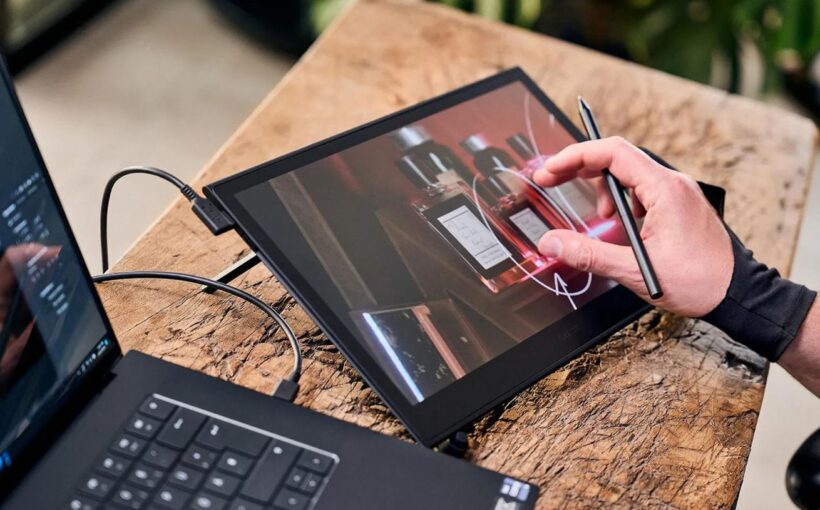
Wacom has thrown a tablet-shaped curveball at digital creatives waiting on Apple’s highly anticipated OLED iPads. The company introduced the Wacom Movink 13 on Wednesday, its own OLED-based offering that targets creatives in need of a highly portable display drawing tablet.
Available now for $750 via the Wacom web store, the Movink features a full HD 13.3-inch Samsung OLED display that gives it several advantages over comparably midrange LED-based tablets. The most notable is the lack of a backlight — not only does that prevent light leakage and excess heat, according to Wacom (the latter being a familiar nuisance for display tablet users), but it also allows the tablet to be more compact.
Wacom says the Movink is the “thinnest and lightest” pen display tablet it has ever made, weighing 420 grams (14.8 ounces) with thickness ranging between 4–6.6mm. By comparison, Wacom says it’s 66 percent thinner and 55 percent lighter than the comparably sized Wacom One 13 touch. That also makes it lighter than the 682-gram (24-ounce) current 12.9-inch iPad Pro model while sharing a similar thickness.
:format(webp)/cdn.vox-cdn.com/uploads/chorus_asset/file/25417747/Wacom_Movink_13_thin.jpg)
It isn’t blighted by those messy three-in-one cables, either — the Wacom Movink 13 uses a single USB-C to USB-C cable for both power and connectivity. The tablet supports Windows, macOS, ChromeOS, and Android, and a second USB-C port is also available for additional power if the connected device doesn’t have enough juice.
:format(webp)/cdn.vox-cdn.com/uploads/chorus_asset/file/25417752/Wacom_Movink_13_android.jpg)
Users can also expect a wider color spectrum and deeper blacks, with a contrast ratio of 100,000:1, a hundred times higher than what’s featured on the recently released Wacom Cintiq Pro 17. The Wacom Movink is validated for Pantone and Pantone SkinTone and provides 100 percent DCI-P3 and 95 percent Adobe RGB coverage, according to Wacom. The faster response time for OLED also lowers pen latency below one millisecond.
Speaking of pens, the Movink comes with a dedicated version of Wacom’s Pro Pen 3 stylus that features a slimmer, more visible nib. This version is exclusive to the Movink 13, but Wacom says the tablet also supports “multiple pen technologies,” allowing it to work with Wacom’s Pro Pen 2 or third-party offerings from Dr. Grip Digital, Lamy, or Staedtler.
That’s it for the free accessories, though — users who prefer to work at an angle will need to purchase a separate (and equally skinny) $80 foldable stand. There are also only two customizable buttons built into the tablet, one on either side, that can be used for things like toggling touch functions on or off. If you need more, then you’ll need to either purchase Wacom’s separate $99 ExpressKey Remote or create some on-screen shortcuts.
:format(webp)/cdn.vox-cdn.com/uploads/chorus_asset/file/25417753/Wacom_Movink_13_touch.jpg)
Given Wacom is the first drawing tablet manufacturer to provide an OLED-based offering, the closest competitor for the Movink 13 will likely be Apple’s long-anticipated OLED iPad Pro, which is expected to be unveiled on May 7th. The most notable difference between the products is that Wacom’s tablet needs to be connected to an external device, but at $750 (which is surprisingly cheap for Wacom), it may be significantly more affordable than Apple’s all-in-one offering.
Unless users are tied to using desktop creative software, the only thing that would make it more difficult to choose between them would be if Apple announced a native way to use the iPad as a drawing tablet on Mac. A girl can only dream.



